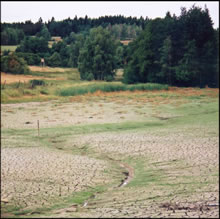Realizing that piecemeal technical solutions have in too many cases proved
insufficient in fighting floods and droughts, environmental experts have
proposed integrated river basin management as the only effective way to
limit the destructive power of water during floods and ensure enough water
during droughts. Effective as it may be, the new concept is also more demading.
Authorities adopt fragmented approach
Slovakia is fortunate to have enough water resources, rivers and dams, but
it is only integrated river basin management that can provide sufficient
quality water in the long term. However, the promising new concept has not
yet been introduced in the country whose authorities responsible for water
management include the Ministry of Environment, the Ministry of Agriculture
and the Ministry of Health. The problem is that each authority sees its
own competence in a fragmented way. The Ministry of Health focuses on ensuring
that households are supplied with quality water; the Ministry of Agriculture
manages some of the rivers, and the Ministry of the Environment is responsible
for overall quality and quantity of water resources.
Paradoxically, when it took over the responsibility for water management
from the Ministry of Agriculture together with its entire team of experts
last year, the Ministry of the Environment did not change the very policy
that it previously criticized. What still goes on, now under the name of
"environmental conservation", is mainly the building of dams,
as the head the Ministry's water section, Anton Supek admits. Yet, Supek
recognizes that an integrated river basin management system must inevitably
be designed. Creating such a system and making it work is a complex task
because it means involving a wide range of stakeholders, among them farmers,
forest rangers, water managers, economists, and many others.
Jan Szolgay of the Slovak Technical University, chairman of the Board of
Integrated River Basin Management at the Ministry of the Environment, shares
Supek's concerns. He admits that until now the Board has only dealt with
dam building. „It is a pity that until now integrated river basin
management has not been included in the curricula of the water management
faculties of the Slovak universities,” Szolgay adds.
NGOs show the way
The best results in translating IRBM theory into practice in Slovakia have
so far been achieved by non-governmental organizations that have recently
started to restore some micro-basins. As early as ten years ago, the People
and Water NGO of Kosice proposed an alternative water management concept
that emphasises integrated, whole-basin conservation. According to the director
of the NGO, Michal Kravcik, the existing ways of drying the land –
deforestation, liquidation of game refuges and green areas, melioration
or extreme cityplanning methods that unnecessarily leave large basin areas
dry – are even more detrimental to the small hydrological cycle than
the greenhouse effect itself.
Fighting the legacy of former Czechoslovakia
Since the fifties, over a quarter of the area of former Czechoslovakia has
been drained as more cereals started to be grown for exports to Russia.
Over 70 per cent of farmland has been ploughed up, and what used to be tiny
strips of land with balks, game reserves and wetlands became almost extinct
in the Slovak part of total agricultural land. Over 8,000 km of streams
have been canalised, and extensive drainage systems with drainage canals
have been built. A team of scientists and experts of the Academy of Science
of the Czech Republic has warned that this has caused grave disturbances
in landscape balance including the hydrological cycle.
In five spring areas, scientists have recently carried out landscape restoration
experiments by planting various timber species and plants, removing drainage
canals, digging out swales/saturation lines, and leaving the meadows to
be grazed by goats. As Oldrich Syrovatka says: "we found that in the
restored micro-basin instead of previous one third of water, today only
one tenth of water leaves the land“. Regular measurements showed that
because of their greater retaining capacity the restored micro-basins could
accommodate both sudden torrents and droughts.
What next?
 |
A dried-out landscape is often
the result of the missing integration between land use and water management |
The “Water for Global Cooling“ conference held in August 2003
in Levoca, Slovakia, called attention to the whole-basin conservation for
which an integrated basin
management is crucial. Most participants called for changes in river basin
management. “Not only water management and forestry, but also agriculture
are now facing changes,” says Christian Wallner of the Regional Department
for Agriculture of the province of Lower Austria. According to him, all
stakeholders of a certain basin should adopt a new approach to economic
activities even at the expense of their yields. Water must be seen as an
equally significant natural product as any crop or timber - if not more
significant. “Farmers should adopt a new crop rotation policy to grow
species that are more resistant to water- and soil-erosion so that the soil
would not lose its nutrients. Moreover, wet meadows should no longer be
drained. Ground plans for urban development should be designed in a way
to ensure least interference with nature”.
The Slovak Minister for the Environment, Laszlo Miklos, a landscape ecologist
by training, claims that the next annual report on water drafted by the
Ministry will emphasize integrated river basin management as the only approach
that can enhance the potential and the quality of water resources. Since
IRBM requires the participation of all stakeholders active in a river basin,
its implementation will not be an easy task; some private landowners may
be reluctant to change their existing land use methods. However, the new
law on waters that has incorporated all related European guidelines will
have to be observed by all, especially once Slovakia becomes an EU member.
Miklos hopes some structural funds will - at least at the beginning - support
the farmers in areas where production is limited by a strict nature and
water resources conservation.
More information:
www.enviro.gov.sk
www.ludiaavoda.sk
www.cas.cz